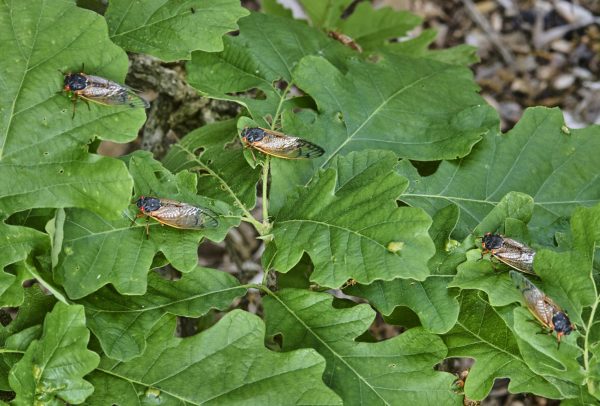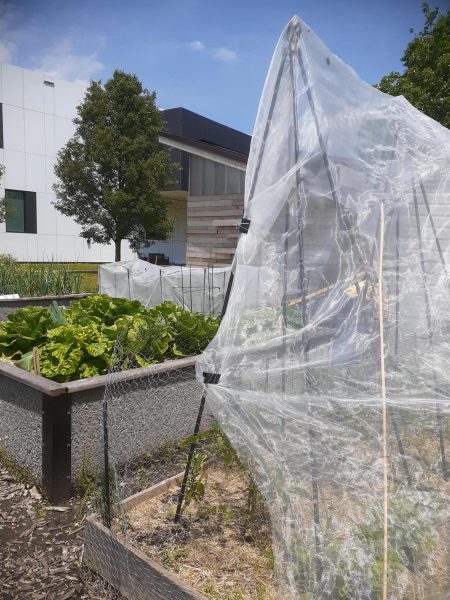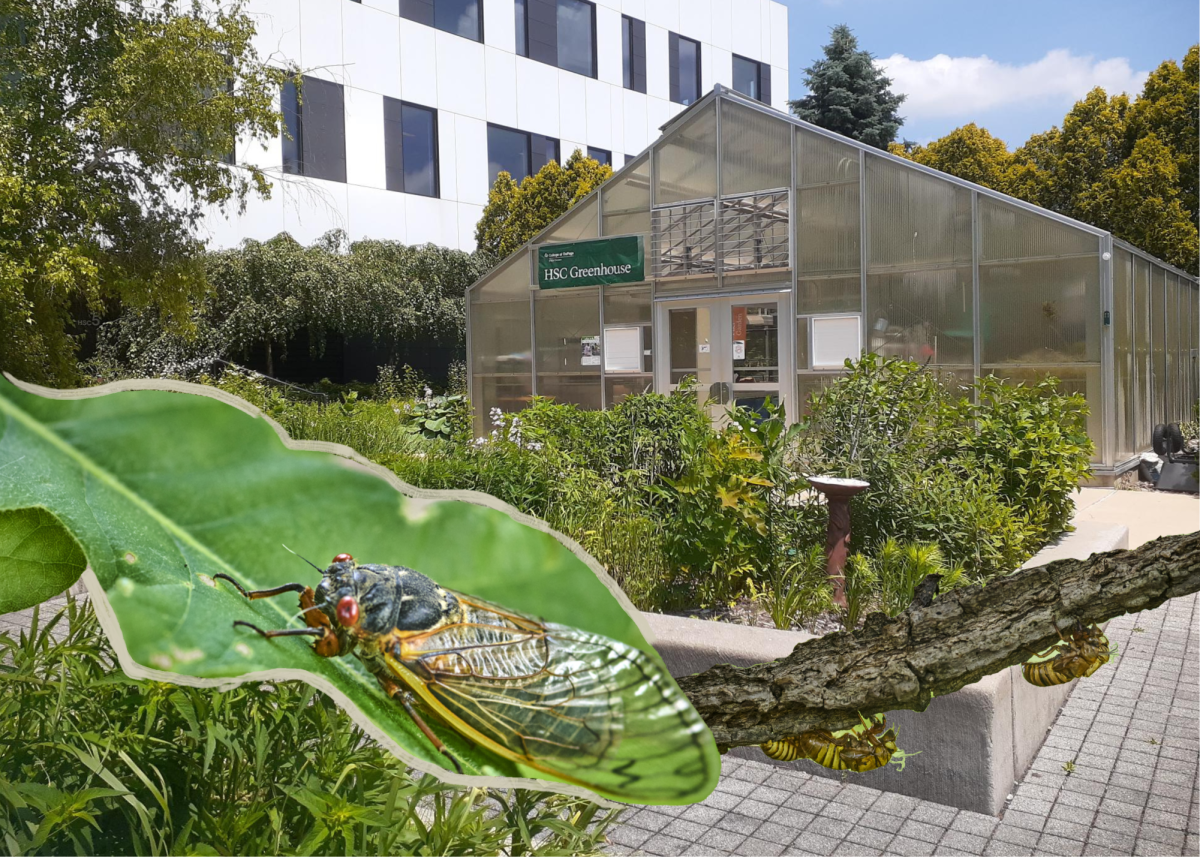Editor’s Note: This article has been updated to correct the brood’s periodic emergence years, locations, and the name of the Hemiptera true bug order.
Open your window on a dry summer day, and you’ll be greeted with a constant buzz from the trees. The sound may be a nuisance to some, but it is captivating to ecologists as the special mating call of cicadas. This year uniquely marks the emergence of two periodical cicada broods. Brood XIII in northern Illinois, Wisconsin and Iowa surfaces every 17 years. Brood XIX in southern Illinois, Missouri and other southeastern states emerges every 13 years.
In COD’s 45 acres of natural areas, woodland and prairies, Brood XIII has not made much of a buzz, according to Anna Bakker, COD’s outdoor lab and prairie manager.
“Cicadas are part of our natural world, and their emergence has been ongoing for millions of years,” Bakker said. “There are more cicadas in the ESA [Ecological Study Area] woodland than anywhere else on campus. Some have occasionally smacked me in the face while driving or working, but other than that it’s business as usual.”
Between mid-May and June, these millions of winged cicadas will molt, mate, lay eggs, then die. All they will leave behind are brown, hollow exoskeletons on tree trunks and wooden fences. Then, by mid-summer, the new generation will hatch as wingless, tan nymphs and return to their underground soil homes.
At the Horticulture program’s greenhouse and small orchard, there also hasn’t been much cicada activity. Greenhouse staff say this is because most of the land had buildings on it 13 years ago, so cicadas had not entered the soil in the area.

While COD is mostly unaffected by the cicada broods, elsewhere in one of DuPage County’s largest public garden and tree research programs, the Morton Arboretum, the cicada emergence has inspired community activities and research projects. The Arboretum’s Plant Health Care Leader, Stephanie Adams, gave some insight into her role in the Arboretum’s netting of 600 trees to protect from cicadas.
“My participation in that was going through our botanical records of our living collections, to see which trees had cicada damage in 2007 after that emergence,” Adams explained. “The horticulturists that oversee the displays of botanic gardens, they made those decisions of which trees are susceptible.”
Adams reminds people that periodical cicadas cause very minimal damage, as they only cut thin-barked small branches to lay eggs. Most trees and vegetation are unaffected, besides saplings which people put protective netting around to prevent cicada damage.
Arboretum researchers also specialize in rare and endangered trees, and Adams described how they are researching the effects of cicadas on endangered trees.
“Monitoring these rare and endangered plants, because some of them may have not originated from here, so they may have never experienced cicada emergence,” Adams said. “One of the long-term monitoring protocols or experiments that our plant healthcare program is doing is to see which are the preferred species [of trees for cicadas,] and then how well do they cope with the damage after it’s happened. Then we’ll be more educated in 17 years, and we’ll be able to be even more specific with our recommendations.”

In COD’s woodlands, Bakker said it’s still too early to notice cicada damage because they haven’t begun to lay eggs yet. The naturalists are not too worried about damage and won’t require netting. Bakker says it’s a part of nature. Locally, more small trees, like keystone oaks, are lost to herbivory deer and rabbits.
Home gardeners can also rest assured the cicadas won’t target flower beds or vegetable patches. Instead, there are some overlooked benefits to the cicada presence, as COD’s Fuel Garden manager Vicki Gerberich describes.
“They offer a lot of benefits to your garden through soil aeration and water filtration,” Gerberich said. “And when they die and decompose, they’ll provide added nutrients to the soil. There is also the possibility that since cicadas are a food source for birds and squirrels, those critters might be less apt to forage in your garden.”
Bakker also described two ecological impacts of the cicadas.
“Exoskeletons and decomposing cicada bodies add nutrients to the soil, almost like a natural fertilizer,” Bakker said. “They provide extra food for other organisms so we would expect to see a boost to other wildlife species populations post-emergence. Food is a scarcity for most species and determines population size. Right now it’s like an all-you-can-eat buffet for organisms that feed off of cicadas.”

This food chain also makes it risky to use insecticides, as they can poison the cicadas, which are consumed by larger animals who will also be poisoned and die. The arboretum strongly advises against using insecticides on cicadas or other native insects.
“Cicadas are in the insect order that includes all true bugs, the Hemiptera. There are a lot of those insects that are part of our natural ecology,” Adams said. “So using any insecticides that would affect cicadas, it would especially affect non-target organisms and cause more harm to the environment than any good of trying to manage the cicadas.”
Adams stated how this preservation of native flora and fauna is an important part of her work.
“My position’s primary role is to support our living collections and plant gardens by working with our horticulturist to identify underperforming plants and diagnose them,” she said. “During the growing season, it is going out into the botanical collections and collecting plant disease samples or working at the horticulture to get plant disease samples to do critical plant diagnostics, develop management plans for these problems, and then, help them monitor the plants and see how it performs.”
Adams reflected on how her skills and passions are realized in the important preservation work of the Arboretum, especially during unique ecological events like the cicada brood emergence.
“I’m really driven by, ‘I like helping people grow plants,’ and because plants usually make people happy,” Adams reflected. “I have this skill set that I help people troubleshoot problems they’re having so they can get their plant to perform how they want it to perform. I’m largely driven by enriching people’s lives through plants.”

Adams encourages students interested in horticulture or botany to seek internships, volunteer or attend the community adult program classes at the Arboretum.
“I have horticulture students who have done things like DNA extraction and PCR and working on research projects,” Adams said. “If they have any interest or even interest in public garden operations, we always are happy to work with COD to create opportunities for their students.”
Learning opportunities at the Arboretum are available on the Opportunities in Science webpage. People may also participate in ongoing projects at the COD’s Natural Areas like weeding invasive species, seed harvesting, and monitoring pond water quality.







